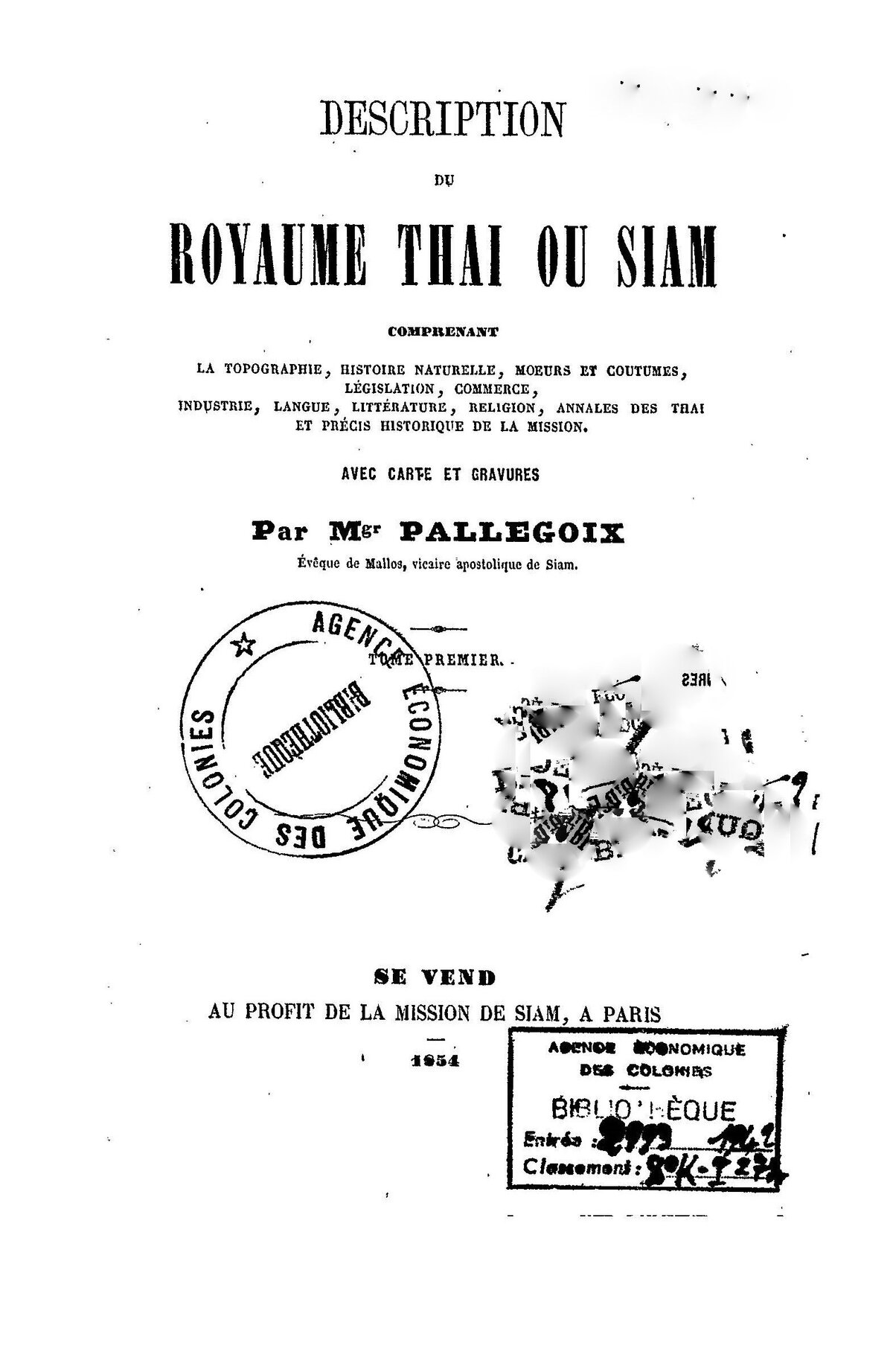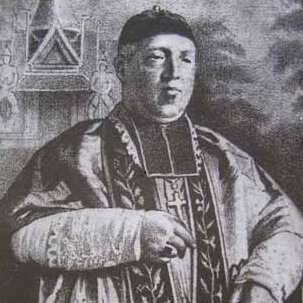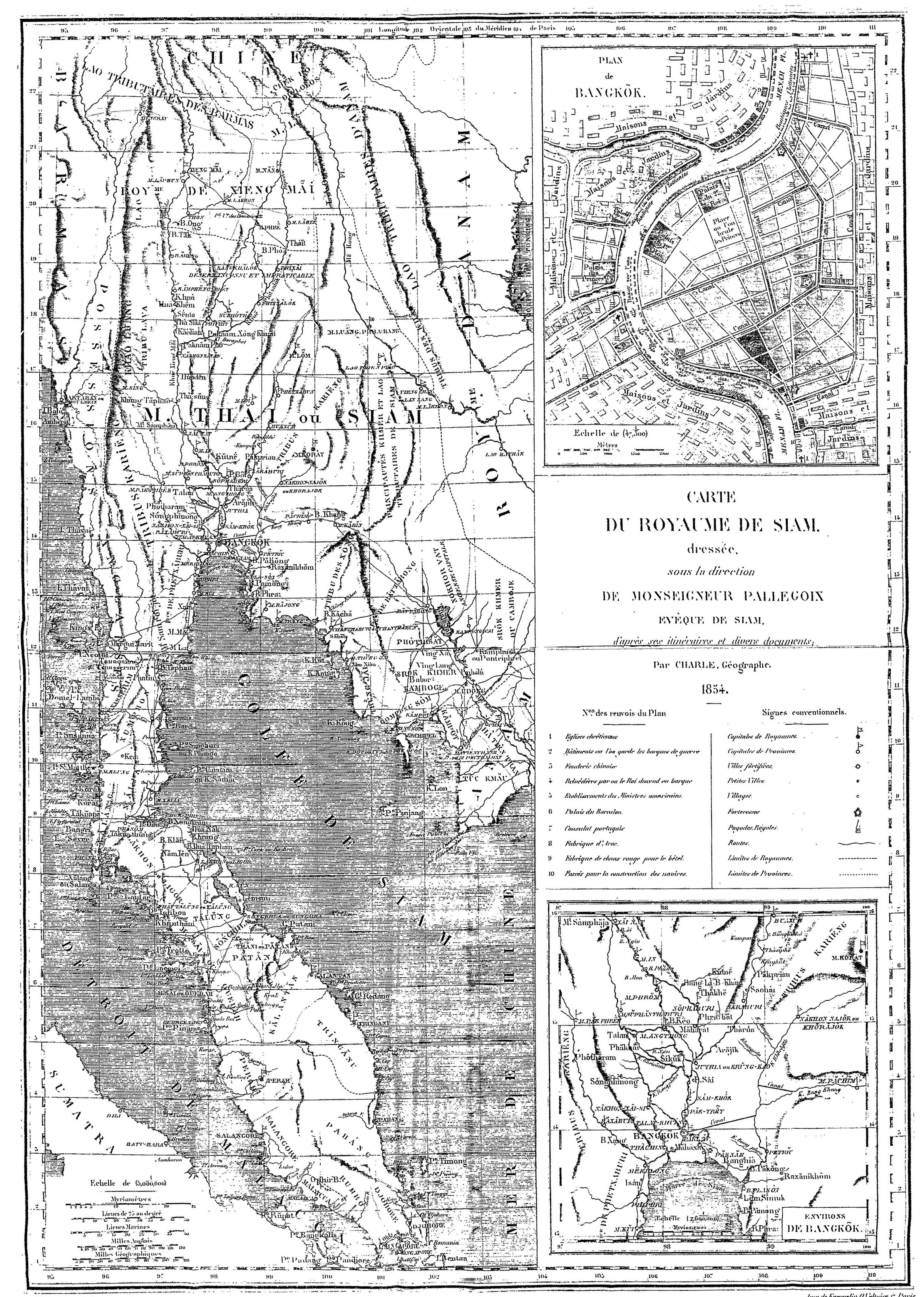Description du Royaume Thai ou Siam
by Jean-Baptiste Pallegoix
An early account of Angkor and pre-colonial Cambodial included in this compendium on the Siamese Kingdom in the 1830s-1850s.

- Format
- e-book
- Publisher
- Imp. Vialat (Lagny), "Au profit de la Mission du Siam a Paris", 2 vol.
- Edition
- pdf via www.gallica.bnf.fr
- Published
- 1854
- Author
- Jean-Baptiste Pallegoix
- Pages
- 953
- Language
- French
The indefatigable apostolic vicar of Siam has been quoted (or plagiarized) many times. His sum on the Kingdom of Siam in the 1830s and 1840s, and on indirectly on Cambodia, Burma and Laos, reflects more his excellent contacts at the Royal Court than actual travels.
His art of reformulating second-hand information cannot hide the fact that his notations of Cambodia are essentially based on hearsay. Even if became a noted linguist and expert in Siam, it is obvious that he was more preoccuped with the development of Catholic missions and churches than with the inhabitants of the vast Kingdom. We shall retain:
- The Great Lake and Angkor and its “marble” buildings: “A l’extrémité nord du Camboge on trouve un joli lac appelé Thalesap, qui a vingt lieues de circonférence. Il est extrêmement poissonneux; tous les ans, quand les eaux sont basses, il s’y fait une pêche considérable d’un gros poisson très délicat, appelé savai, qu’on sale avec les cendres du palmier, ce qui donne à sa chair une saveur douce et sucrée. C’est près des rivages de ce lac [Tonle Sap] que sont situées les ruines merveilleuses de Nokorvat. Elles consistent en un vaste palais en colonnes, pyramides et temples ou pagodes, le tout construit en marbre taillé et ciselé; on y remarque des dômes et des voùtes d’un travail si surprenant, que les Cambogiens n’en parlent jamais sans dire que c’est l’ouvrage des anges et non pas des hommes. Il est probable que ces ruines remontent au temps du du fameux roi de Camboge Phra-Pathum-Surivong, sous le règne duquel un talapoin de Ceylan apporta les livres sacrés des Bouddhistes et introduisit la religion de Buddha dans cette contrée.” [“At the northern end of Cambodia, we find a pretty lake called Thalesap, which is twenty leagues in circumference. It is full of fish; every year, when the water is low, there is a considerable catch of a large one, very delicate fish, called savai, which, when seasoned with the ashes of the palm tree, has a flesh with a sweet and sugary flavor. It is near the shores of this lake [Tonle Sap] that are located the marvelous ruins of Nokorvat They consist of a vast palace, of which columns, pyramids and temples or pagodas, the ensemble is built of carved and chiseled marble; one notices domes and vaults of such surprising workmanship that the Cambodians never speak of them without say that it is the work of angels and not of men. It is probable that these ruins date back to the time of the famous king of Cambodia Phra-Pathum-Surivong, under whose reign a talapoin from Ceylon brought the sacred books of Buddhists and introduced the religion of Buddha to this land.”] [Note: This description appears word for word in Sir John Bowring’s The Kingdom and People of Siam, London, 1857, vol 2, pp 23 – 24]
- The legend of the Leper King: “Dans les siècles passés, Somana-Khôdom, étant .venu un jour recevoir des aumônes dans la capitale du Camboge, appelée Muan-Inthapat, un mendiant lépreux vint offrir à Bouddha un peu de riz dans son coco, et, en versant le riz dans la marmite du saint, la secousse qu’il donna fit tomber son petit doigt avec le riz, ce qui n’empêcha pas Phra-Khôdom de manger son riz en écartant toutefois le doigt du mendiant, et après son repas, il prophétisa qu’en récompense de son aumône, ce rnendiant régnerait un jour dans cette capitale.” [“In the past centuries, Somana-Khôdom, visiting one day to receive alms the capital of Camboge (called Muan-Inthapat), a leper beggar came to offer Buddha a little rice in a coconut, and, while pouring the rice in the pot of the saint, the shaking he gave caused his little finger to fall with the rice, which did not prevent Phra-Khôdom from eating his rice — however removing the beggar’s finger –, and after his meal he prophesied that as a reward for his alms, this beggar would one day reign in this capital.”]
- The origin of Angkor: “Le nouveau roi, nommé Phra-Chào-Uthong, régna sept ans à Inthapat-Nakhon [probably Mahendraparvata]; mais la contrée ayant été ravagée par une peste terrible, Phra-Uthong, avec tout son peuple, abandonna le pays et, s’étant dirigé vers le sud-ouest, après vingt jours de marche, il arriva au bord d’un grand fleuve ou il trouva une île d’une forme ronde. Il passa la rivière pour visiter cette île, et il y trouva un ermite qui lui dit que dans les siècles passés Somana-Khôdom était venu là et avait prédit que dans la suite on y bâtirait une grande ville.” [“The new king, named Phra-Chào-Uthong, reigned seven years in Inthapat-Nakhon [probably Mahendraparvata]; but the land having been ravaged by a terrible plague, Phra-Uthong, with all his people, abandoned the country and, heading southwest, after twenty days of walking, he reached the edge of a great river where he found a round-shaped island. He crossed the river to visit this island, and he found a hermit there, who told him that in past centuries Somana-Khôdom had come there and predicted that in the future a big city would be built there.”]
- Siam-Khmer relations: “[Siamese King] Phra-Chao-Tong-Lam fut tué par son frère Phra-Rame-Suén en 1382, après avoir régné trois jours seulement. (…) Celui-ci prit la capitale du Camboge en 1385 (747 ere siamoise), et n’y laissa que cinq mille âmes.” | “Le roi Mahâ-Cha-kraphat-Raxa-Thiràt prit la capitale du Camboge s’appelait alors Lavëk [Longvek] en 1532; le roi vaincu lui livra ses fils en otage; le vainqueur en choisit un qu’il établit roi de Sangkhalôk.” | “Depuis longtemps le roi de Juthia [Ayuthya] avait fait le serment de se laver les pieds dans le sang du perfide roi de Camboge. Dès qu’il fut délivré de ses autres ennemis, il alla assiéger Lavëk; les Cambogiens se battirent en désespérés; le siége dura plusieurs mois; (…) Lavëk fut prise d’assaut et le roi du Camboge, chargé de chaînes, fut amené aux pieds de son vainqueur. Phra-Narèt, du haut de son trône, annonça lui-même la sentence au roi vaincu (…). Alors retentirent les cymbales, les tambours et autres instruments de musique pendant qu’on égorgeait le pauvre monarque dans une tente voisine. Son sang encore tout chaud fut apporté’ dans un grand bassin d’or devant Phra-Narèt, qui eut le courage barbare de s’y laver les pieds au son des cymbales et autres instruments.” [Siamese King “Phra-Chao-Tong-Lam was killed by his brother Phra-Rame-Suén in 1382, after having reigned only three days. (…) The latter took the capital of Camboge in 1385 (747 Siamese era), and left only five thousand souls.”|“King Mahâ-Cha-kraphat-Raxa-Thiràt seized the capital of Camboge, then called Lavëk [Longvek] in 1532; the vanquished king offered his sons as hostages to him; the victor chose one whom he establishes king of Sangkhalôk.”|“For a long time the king of Juthia [Ayuthya] had taken the oath to wash his feet in the blood of the perfidious king of Camboge. As soon as he was delivered from his other enemies [Laos], he went to besiege Lavëk; the Cambogians fought in desperation; the siege lasted several months; (…) Lavëk was finally submitted and the king of Cambogia, laden with chains, was brought to the feet of the conqueror. Phra-Narèt, from his throne, announced the sentence to the conquered king (…). Then the cymbals resounded drums and other musical instruments while the poor monarch was slaughtered in a nearby tent and Phra-Narèt, who had the barbarous courage to wash his feet there to the sound of cymbals and other instruments. ”
- Marriage and divorce: “Le mariage n’est défendu que dans le premier
degré de parenté; les princes s’unissent très-souvent à leurs proches parentes pour né pas s’allier à des familles d’un rang inférieur. En général, les ménages sont assez heureux; cependant le divorce n’est pas une chose rare, surtout parmi le peuple. Quand la femme exige un écrit de divorce, le mari né le refuse guère, parce qu’il serait presque toujours forcé par les juges à le donner; alors il rend sa dot à sa femme et ils se partagent les enfants en cette manière : la mère a le premier, le troisième et tous les autres en rang impair; le mari a le second, le quatrième et les autres en rang pair. S’il n’y a qu’un enfant, c’est pour la mère.” [“Marriage is forbidden only in first degree relationships; the princes very often mate with their close female relatives, to avoid alliances with families of an inferior rank. Generally, households are quite happy; however, divorce is not a rare thing, especially among the people. When the wife demands a written divorce settlement, the husband hardly refuses, because he would almost always be forced by the judges to give it; then he returns his dowry to his wife and they divide the children among themselves in this way: the mother has the first, the third and all the others in odd rank; the husband has the second, the fourth and the others in even rank. If there is only one child, it is for the mother.”] - Early US-Siam relations: “Le traité [stipulant que] les Siamois et les citoyens des États-Unis d’ Amérique entretiendront loyalement des rapports de commerce dans les ports de leurs nations respectives aussi longtemps que le ciel et la terre dureront a été conclu mercredi dernier, dernier jour du quatrième mois de l’année 1194, appelée pimarong-chatava-sok (ou année du Dragon), date qui correspond au vingtième jour de mars de l’an de notre Seigneur 1833. L’un des originaux est écrit en siamois, l’autre en anglais. Mais, comme les Siamois ignorent l’anglais, et les Américains le siamois, une traduction portugaise, et une en chinois, ont été annexées aux originaux pour servir de témoignage à leur contenu.” [“The treaty [stipulating that] the Siamese and the citizens of the United States of America shall have fair trade relations in the ports of their respective nations as long as heaven and earth last, was concluded last Wednesday, the last day of the fourth month of the year 1194, called pimarong-chatava-sok (or year of the Dragon), the date which corresponds to the twentieth day of March in the year of our Lord 1833. One of the originals is written in Siamese, the another in English. But, as the Siamese have no knowledge of English, and the Americans of Siamese, a Portuguese translation, and a Chinese one, had been appended to the originals to serve as testimony to their content.”]
- Usefulness of Pallegoix’ work on Thai language: The Protestant missionary Rev. McGilvary (1828−1911), in A Half-Century Among the Siamese and the Lao: An Autobiography, noted: “Pallegoix’s Dictionarium Linguae Thai, and his short Grammar in Latin, were all the foreign helps we had. The syntax of the language is easy; but the “tones,” the “aspirates,” and “inaspirates,” are perplexing beyond belief. You try to say “fowl.” No, that is “egg.” You mean to say “rice,” but you actually say “mountain.”
The map published by Pallegoix in 1854 shows a real knowledge of Cambodian realities, if not geography. He is one the few Western authors at that time to use the term “Srok Khmer” (Land of the Khmer), and rightly places Kampong Suai [Kompong Svay] as the provincial capital city closest to Nokor Vat (Angkor).
Read the ebook
Full title: Description du Royaume Thai ou Siam comprenant la topographie, l’histoire naturelle, les moeurs et coutumes, législation, commerce, industrie, langue, littérature, religion annales des Thai et précis historique de la mission.
English translation: Description of the Thai Kingdom or Siam: Thailand Under King Mongkut, White Lotus Press, Bangkok, 2000
Tags: 19th century, French travelers, Siam, Tonle Sap, pre-colonial Cambodia, Lao, linguistics
About the Author

Jean-Baptiste Pallegoix
Mgr. Jean-Baptiste Pallegoix (24 Oct. 1805, Combertault, France – 18 June 1862, Bangkok, Siam (Thailand)), vicar apostolic of Eastern Siam from 1838 to his death, was a French missionary who extensively studied Thai language and society.
A close friend of King Mongkut (Rama IV) of Siam — who attended in person his funerals –, he was free to travel across the Kingdom or to send emissaries, and was involved in France’s early attempts of establishing contacts with Cambodia, then vastly under Siamese rule. He also acted as an intermediary for the establishment of official relations between France and Siam, thanks to his access to French diplomat Louis Charles de Montigny, who signed the French-Siamese Treaty on 15 Aug. 1856.
Author of Latin-Thai-French-English dictionaries, he mentioned several times Angkor and the history of Cambodia in his Description du Royaume thai ou Siam, even if many of his descriptions were not first-hand. He signed the latter book as “évêque de Mallos [Bishop of Mallos, an ancient city of the Roman region of Pisidia, a titular see of the Roman Catholic Church], vicaire apostolique de Siam”.

